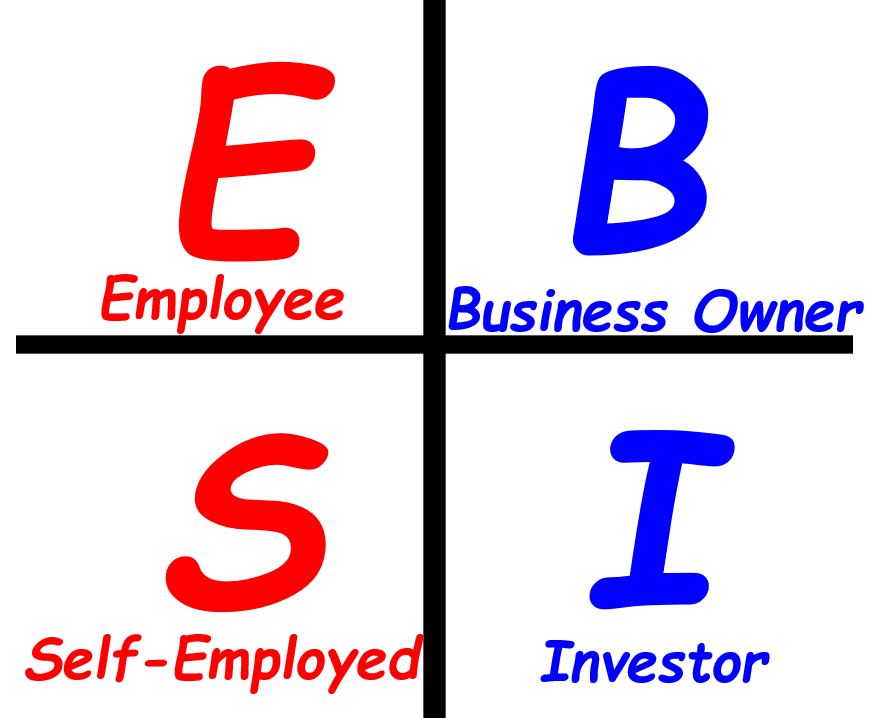In Cash Flow Quadrant, Robert Kiyosaki explains that there are four ways to make money. You can be an employee (E), working for someone else for a salary. Alternatively, you can be self-employed (S), a business owner (B) or an investor (I). If you compare the E and S quadrants to the B and I quadrants, you’ll find some important differences.

E’s and S’s have jobs. E’s work for someone else. S’s work for themselves. Either way, they work for their money. When they don’t show up to work in the business, work doesn’t get done. In contrast, B’s and I’s don’t need to show up to work every day. In fact, Kiyosaki says that a good test to determine if you are an S or a B is to ask, “Can I leave?” If you are a B you can leave for extended periods without impacting the operation or your income. If you are an S, you can’t.
There’s another good test that will tell you if someone is an E or S versus a B or I. Ask them what they want. If someone is an E or an S they are likely to tell you what they don’t want. “I don’t want debt.” “I don’t want conflict.” “I don’t want weeds.” E’s and S’s expend a lot of energy trying to keep bad things from happening.
Ask a B or an I what they want and they will tell you. “I’m trying to create…” “I want to provide…” “Within 5 years I want to have…” Most of their energy is focused on creating a positive outcome. Of course, working through problems and challenges is part of running every business, but there is a long-term positive vision of the future that drives business owners.
Focusing on the negative can be motivating. It’s fight or flight. But whether fleeing or facing the thing that’s attacking us, focusing on the negative is expensive, exhausting and demoralizing.
I’ve found that instead of running away from the bad, running towards a dream tends to enrich us financially and spiritually. Of course, we need to know that the dream is economically and financially viable. (The processes we teach in the Ranching For Profit School can help you vet your vision to determine if it is a dream or a nightmare.)
Managing for what you want is a more powerful way to manage. It is a more powerful way to live.




I live in south east MN and have terrible thistle problems. I’ve tried several different grazing strategies to try to control them but it seems once they take over an area all I can do is spray or mow them. And they keep coming back. It is on my best land where I grow the most grass but the thistles are slowly taking over. Any Ideas?
I find it culturally difficult to be at peace with the weeds my father made war on. That said, I have found it helpful to take a somewhat mathematical approach to weeds. Looking over a paddock, I like to try and calculate what percentage of the ground is being used by non-grazable weeds. Next, what’s the trend? Directly observing ecological succession moving toward more desirable plants is pretty comforting.
Stephen Covey wrote, “We see the world, not as it is, but as we are.”
Maybe when we see problems to be solved, weeds, financial loss,etc., it is an extension of something deeper in us, a negative in us. To see a path toward what is desired, instead of slaying dragons all the time, requires more than a change of action but a change of mind, that is to say a change of who we are?
Tell me about how you handle healthcare in your own family: Do you never take pain relievers? Do you never take antibiotics?
And your livestock: Do you not vaccinate? Do you not treat pneumonia, footrot, scours?
Fifteen years ago we had a terrible problem with tall larkspur in our upper pastures – which caused my mother-in-law to hold the cattle along the river until the larkspur dried out.
Which caused the river field to be overgrazed and overrun with thistle.
Once we controlled the larkspur – with Tordon – we were able to put the cattle up on those pastures sooner. And we rotated those cattle better – which helped in controlling the larkspur.
We sprayed the river fields – with Tordon – which controlled the thistle.
It’s all a process – and it all takes time.
Generally if cattle are grazed at the highest density possible and with the shortest rotation possible (ideally moving them at least once a day)the pasture will improve and move towards desirable species. There needs to be enough cows in a small enough area that they carelessly trample the “weeds” as they aggressively graze the better forage. They need a new paddock before they chew the desireables to the ground. You want them to cream the top half of the good plants but still leave the bottom leaves so the good plants will come back quickly and outgrow the weeds. My own tendancy is to overgraze , but the more you leave and trample in , the quicker it grows back and builds the soil.
We swath graze weedy paddocks in June to turn weeds into feed rather then seed. Canada thistle is a very good feed if cut and crimped BEFORE they bloom. Running them try the conditioning rolls helps a lot with palatability. Cattle will readily eat them in the swatch if they are mixed in with some clover and grass, and it has not more than two days since they were cut. Budded out but prebloom thistle will not set seed and you can get an 80 to 90% kill w/o chemicals.
Thanks for your comment. I know it’s hard when you see so many thistles, but I suggest you try not to look at this as a thistle problem. Think of it as a problem with the grass not being competitive enough. Spraying thistles does not make the land healthier…in fact, because it reduces biodiversity it keeps the welcome mat our for weeds. So, what will it take to make the grass more competitive? It’ll boil down to several things:
1. Getting the recovery periods right (how long they should be will depend on the growth rate of the grass.)
2. Using short graze periods, how short depends on the recovery you need, livestock performance need and the relative forage supply in the paddock.
3. Getting stock density up there…how far up there, I don’t know. It’s a variable you’ll need to experiment with…but higher will be better.
4. How you’ve been applying hoof impact. It may help to jump start succession…on the other hand thistles can thrive on disturbance, so I wouldn’t want it every time I graze the paddock. As they say, timing is everything.
5. How you’ve matched the stocking rate to the carrying capacity. Some (unfortunately not all) thistles are sensitive to light competition, So, leaving plenty of residue entering the growing season can give desirable forages the edge.
There are other things that could be at play, it this is a place where livestock have historically concentrated there may be a lot of N in the soil which can work to the advantage of the thistles. Unfortunately, it’s not possible to give you a one-size fits all prescription, especially without being on-site.
We have started to focus our concern on the 25% of the pasture that is infested with low succession grasses and are worrying less about the 1% of the pasture infested with broad leaf weeds.
Have also begun to experiment with higher density grazing and hoof effect. It seems to be more of a treatment method than a grazing system. Currently I think it can be useful for specific conditions at specific times of the year.
I would spray the thistles for two years and then the grass will have an advantage. Craziest thing I’ve ever heard of putting them in the hay. Someone has never had a thistle thorn in their body!
Think of a pasture like this, we are grass farmers and we harvest it with cattle. More grass more cattle u can run.
Question for anyone that mob grazes; what is the total acres your cattle have access to year round? Not just the good times!
Now how many cattle do you graze per acre?
I’m thinking of going to cell grazing?
Don’t try to control them. Graze to make other things thrive. The goal isn’t to kill the weeds but to grow more grass. If you’d like to discuss your specific situaiton I’d be happy to talk with you.